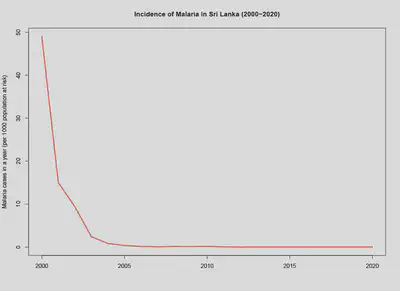2016

Overview
Sri Lanka was WHO certified malaria-free in 2016 with the last indigenous case being reported in 2012. Prior to its Malaria Eradication Program, Sri Lanka had a massive malaria outbreak in 1934 with more than 80,000 deaths and approximately 1.5 million individuals affected. To reduce the malaria burden, DDT spraying began in 1946 and the Malaria Eradication Program was established in 1958. Malaria also became a notifiable disease in 1961. In 1963, near eradication was achieved with only 17 cases documented. With the reduction in cases, commitment to eliminate malaria faltered and this led to the resurgence of malaria with more than 500,000 cases being reported in 1969. During the 1970s, Sri Lanka increased its malaria control and prevention efforts with indoor residual spraying and treatment of cases with chloroquine and primaquine. Malathion was also introduced as an alternative as DDT resistance increased. An intensive malaria control program was also launched in 1977 that included indoor residual spraying supplemented by other control methods like larvicide, case detection and treatment, expanded laboratory services, and health education. Mobile malaria clinics and other surveillance strategies were deployed throughout the 1980s and 1990s. In 2003, Global Fund support began. In the 2000s, Sri Lanka further intensified its malaria control and prevention measures through increased training of health workers, improved malaria surveillance, and use of insecticide-treated mosquito nets.
Malaria Incidence in Sri Lanka (2000-2020)
| Year | Incidence of malaria (per 1,000 population at risk) |
|---|---|
| 2000 | 48.633095 |
| 2001 | 15.293479 |
| 2002 | 9.445145 |
| 2003 | 2.377006 |
| 2004 | 0.834259 |
| 2005 | 0.364822 |
| 2006 | 0.130461 |
| 2007 | 0.043386 |
| 2008 | 0.141200 |
| 2009 | 0.114726 |
| 2010 | 0.146775 |
| 2011 | 0.026430 |
| 2012 | 0.004870 |
| 2013 | 0 |
| 2014 | 0 |
| 2015 | 0 |
| 2016 | 0 |
| 2017 | 0 |
| 2018 | 0 |
| 2019 | 0 |
| 2020 | 0 |
References
Karunaweera, N. D., Galappaththy, G. N., & Wirth, D. F. (2014). On the road to eliminate malaria in Sri Lanka: lessons from history, challenges, gaps in knowledge and research needs. Malaria journal, 13(1), 1-10.
World Health Orgnization. (2016). Malaria-Free Sri Lanka. Accessed from: https://apps.who.int/iris/bitstream/handle/10665/251824/9789290225423-eng.pdf?sequence=1.
Premaratne, R., Wickremasinghe, R., Ranaweera, D., Gunasekera, W. M., Hevawitharana, M., Pieris, L., … & Mendis, K. (2019). Technical and operational underpinnings of malaria elimination from Sri Lanka. Malaria Journal, 18(1), 1-12.